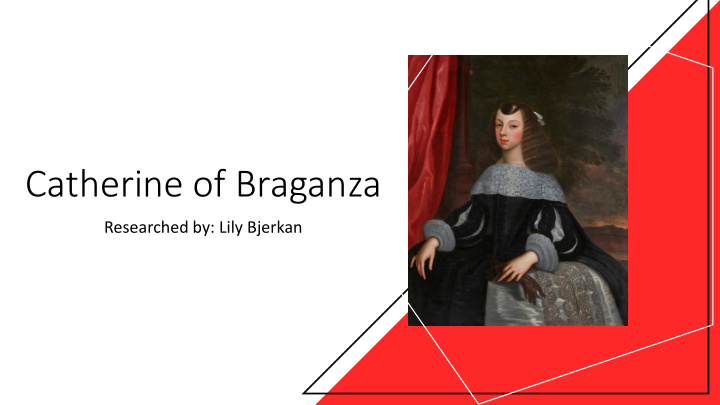



Catherine of Braganza Researched by: Lily Bjerkan
Overview • Interest in Catherine of Braganza • Thesis • Research Question • Road Map • Arrival & Wedding • Methodology • Contemporary English Society • Court and Public Reactions • King Charles II ’ s Treatment • Wedding Celebrations • Brief Overview of Sources • Diaries • Biographies • Other Secondary Sources
Personal Interest • The education I am receiving at Illinois Wesleyan includes double-majoring in History and International Studies with a hopeful minor in Women ’ s and Gender Studies • If you look at my research project, my main focus is a compellation all of those areas coming together; Catherine of Braganza is a female historical figure in England from a foreign country • I have only done one research project on a comparable scale at school before and also focused on am important female historical figure, women are often overlooked or are written out of the common history and I enjoy bringing their stories to light • At the start of the semester we heard three different people in the same week say something about Catherine of Braganza and tea-drinking, I wanted to know the validity in their claims
Research Question Is there reason to believe there is a fault in the historiography of Catherine of Braganza's influence and ability to popularize tea drinking in Great Britain?
Methodology • When I started my project I became too involved in trying to learn everything about Catherine, needed to focus on tea • Had found two great biographies and articles on her marriage • Looked up etiquette books for the English and Portuguese • Led to “The English Housewife in the seventeenth and eighteenth century” • From there I was introduced to memoirs and diaries • “Memoirs of the Court of England during the reign of the Stuarts” • John Evelyn and Samuel Pepys’ diaries
Methodology • In lacking Catherine focused primary sources, I contacted two scholars who are experts in Stuart England • Professor Michael Young: retired professor from Illinois Wesleyan University • Professor Robert Bucholz: expert in Charles II ’ s court, friend of Dr. Young, currently teaching at Loyola University in Chicago • Brought to my attention no new work has been done on Catherine and that there are not many primary sources either, essentially given an ok to use as many helpful secondary sources I could find • Dr. Young recommended “ The Curious World of Samuel Pepys and John Evelyn ” • Knowing secondary sources, I spent more time with what ended up being my golden sources from the beginning
The Golden Sources • Catherine of Braqanc̨ a, Infanta of Portugal and Queen-consort of England , Lillas Campbell Davidson, 1908 • Lives of the Queens of England, from the Norman Conquest [to the Death of Queen Anne]; with Anecdotes of Their Courts , vol. VIII, Agnes Strickland, 1840 • Rites of Deliverance and Disenchantment: The Marriage Celebrations for Charles II and Catherine of Braganza, 1661-1662, Lorraine Madway, 2012
Sources • Primary Sources • The Portugues Asia: or the history of the Discovery and Conquest of India By the Portugues (vol. 1), Manuel de Faria y Sousa translated by Captain John Stevens, 1694 • [A Set of Seven Large Plates by D. S. … ], Dirck Stoop, 1662. • The Diary of John Evelyn , 1649-1697 John Evelyn, 1818 • Secondary Sources • The Curious World of Samuel Pepys and John Evelyn , Margaret Willes, 2017 • Memoirs of the Court of England during the reign of the Stuarts, John Heneage Jesse, 1857 • The English Housewife in the seventeenth and eighteenth centuries , Rose Bradley, 1912
Thesis What can be gathered from available evidence is yes, accountability of the historiography on Catherine of Braganza introducing and popularizing tea-drinking in Great Britain can be questioned
Road Map Observing: • What English and Portuguese courts looked like at the time of Catherine ’ s arrival in England • The ceremonies and celebrations that took place in honor of Catherine and Charles II ’ s wedding • And how Charles II treated Catherine before and after she admitted his mistress, Lady Castlemaine, into her ladies of the bedchamber Mainly through … . • Examining reactions from the court and public • Gathering information from nineteenth and early twentieth century biographies
Recommend
More recommend